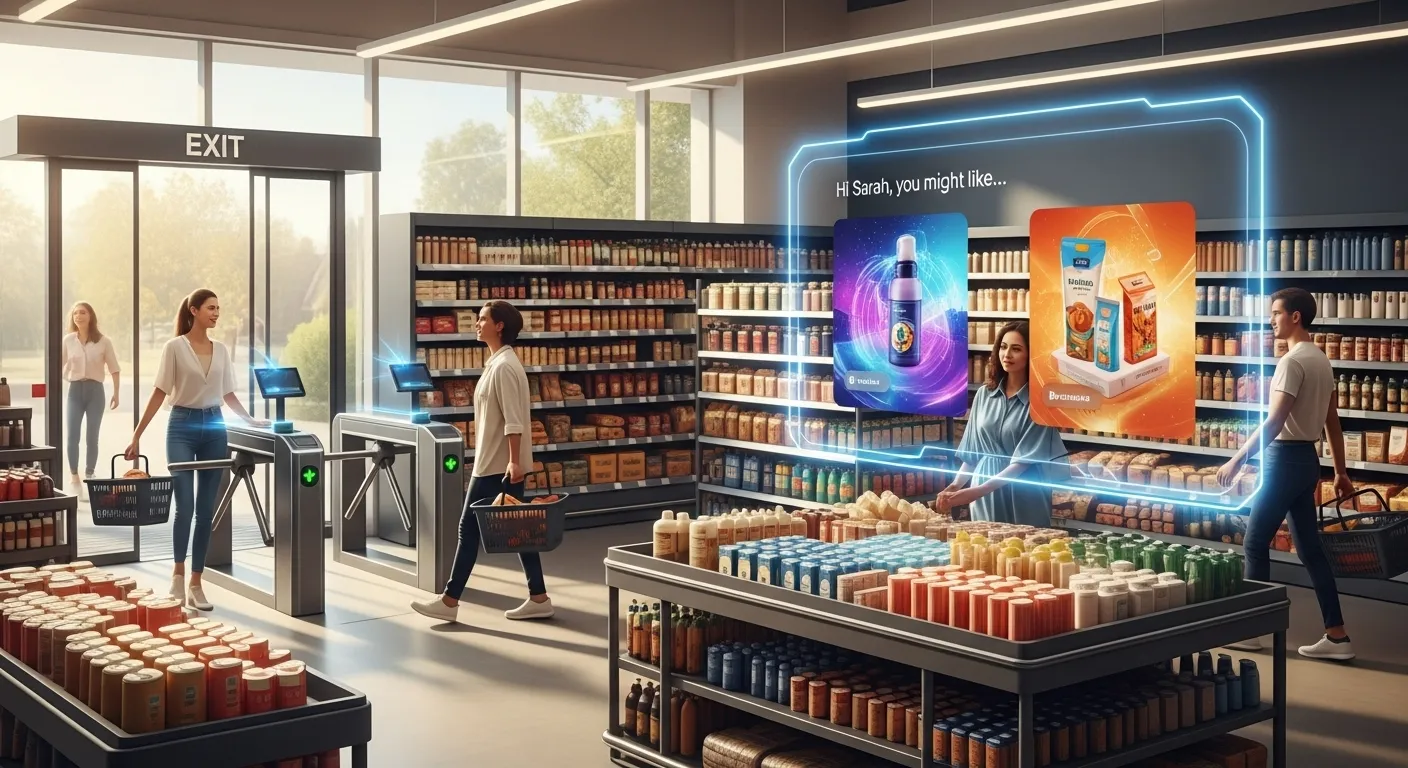Imagine walking into a store, grabbing what you need, and simply walking out—no lines, no scanning, no awkward small talk. This isn’t science fiction; it’s the new reality powered by AI. From cashierless checkout to eerily accurate product suggestions, artificial intelligence is completely reshaping the retail experience. Let’s pull back the curtain on how it all works.
What Is AI in Retail?
AI in retail is like giving stores a super-powered brain. It uses computer vision, deep learning, and sensor fusion to automate the shopping experience and understand customer behavior on a massive scale. The two most visible applications are cashierless checkout systems (often called “Just Walk Out” technology) and sophisticated recommendation engines that know what you want before you do.
How Cashierless Tech Works
When you enter a cashierless store, a symphony of technology tracks your journey:
- Entry & Identification: You typically check in with an app or credit card, creating a virtual shopping cart tied to your account.
- Item Tracking: Hundreds of ceiling-mounted cameras and weight sensors in shelves work together. They track which items you pick up and, crucially, which ones you put back.
- Virtual Cart Management: As you shop, your virtual cart updates in real-time. The AI distinguishes between different shoppers, even if they’re standing close together.
- Checkout & Payment: You just walk out. The system finalizes your cart and charges your saved payment method, sending a digital receipt minutes later.
Benefits & Use Cases
- Frictionless Shopping: The biggest win for customers is convenience. No lines means a faster, more pleasant experience, perfect for busy commuters and parents.
- Hyper-Personalized Marketing: AI recommendation systems analyze your past purchases, browsing history, and even what similar customers buy to suggest products you’re likely to love, dramatically increasing average order value.
- Optimized Inventory & Loss Prevention: Stores know exactly what’s selling in real-time, reducing out-of-stock scenarios. The advanced tracking also significantly cuts down on shoplifting.
- Use Case — The Smart Convenience Store: Perfect for urban areas, these small-format stores can operate 24/7 with minimal staff, serving customers who need to grab a quick meal or coffee without the wait.
Costs & Implementation
This tech isn’t cheap. Implementing a full-scale cashierless system from a provider like Amazon can run into millions for a standard-sized grocery store, covering hardware (cameras, sensors) and complex software integration. For recommendation engines, costs are more scalable. Businesses can start with API-based services from platforms like Google Cloud or AWS, which might cost a few thousand dollars per month, scaling with usage. The ROI comes from increased sales, labor savings, and reduced shrinkage.
The US Retail Shift
In the United States, the adoption is accelerating beyond the early Amazon Go stores. Major players like Walmart are testing similar “scan-and-go” tech, while regional convenience chains like Wawa are piloting cashierless concepts. The drive for efficiency and the high cost of labor in the US make it a prime market for this automation. Furthermore, American consumers’ comfort with app-based payments and data sharing has created a fertile ground for these AI-driven experiences to thrive.
Alternatives & Comparisons
- Full Cashierless (e.g., Amazon Just Walk Out):
Pros: Ultimate convenience, fully automated, high-tech appeal.
Cons: Extremely high upfront cost, complex installation, privacy concerns for some. - Hybrid Scan-and-Go (e.g., Sam’s Club):
Pros: Lower cost, uses customer’s smartphone, easier to implement.
Cons: Still requires customer action, potential for user error or dishonesty. - Traditional Checkout with AI Recommendations (e.g., Target, Netflix-style online):
Pros: Improves sales with minimal disruption, widely accepted.
Cons: Doesn’t solve the in-store friction of waiting in line.
How to Implement AI Retail Tech
- Audit Your Needs: Start small. Do you need a full cashierless overhaul, or would a powerful recommendation engine on your website provide more immediate value?
- Choose Your Tech Partner: Research providers. For cashierless, look at Amazon, Standard Cognition, or Zippin. For recommendations, consider Salesforce, Adobe Sensei, or cloud AI tools from Google or Microsoft.
- Pilot in a Controlled Environment: Roll out the technology in a single store or a specific section first. Use this to gather data, train staff, and manage customer feedback.
- Integrate and Scale: Connect the new AI systems with your existing POS, inventory, and CRM platforms. Once the pilot is successful, plan a phased rollout.
- Communicate and Educate: Be transparent with customers about how the technology works and the data it uses. Clear signage and simple instructions are key to adoption.
FAQs
Is cashierless technology an invasion of privacy?
Providers state that the focus is on tracking product movement, not creating a video profile of the shopper. The AI is generally trained to identify actions (e.g., “product taken from shelf A”) rather than personally identifying individuals. However, it’s wise to review the privacy policy of any store using this technology.
How accurate are AI recommendation systems?
Extremely accurate. By analyzing vast datasets of purchase history, browsing behavior, and demographic information, these systems can predict customer preferences with stunning precision, often leading to a 5-30% increase in sales for retailers who use them effectively.
Will AI put retail workers out of a job?
While it may reduce the number of cashier roles, it creates demand for new positions like AI system managers, data analysts, and customer experience specialists focused on helping shoppers navigate the new technology. The nature of retail jobs is shifting, not necessarily disappearing.
Bottom Line
AI in retail is no longer a futuristic concept—it’s a present-day tool driving efficiency, personalization, and convenience. While the flashy cashierless stores grab headlines, the quiet power of recommendation engines is already boosting bottom lines everywhere. The stores of the future will be smarter, faster, and built around you. What do you think—are you ready to just walk out?

